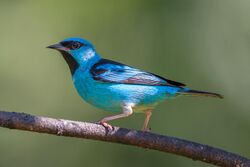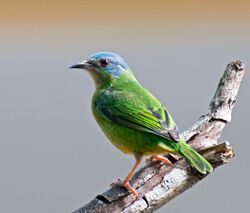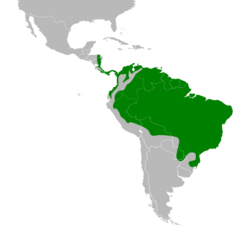Biology:Blue dacnis
| Blue dacnis | |
|---|---|

| |
| Adult male | |

| |
| Adult female in São Paulo, Brazil | |
| Scientific classification | |
| Domain: | Eukaryota |
| Kingdom: | Animalia |
| Phylum: | Chordata |
| Class: | Aves |
| Order: | Passeriformes |
| Family: | Thraupidae |
| Genus: | Dacnis |
| Species: | D. cayana
|
| Binomial name | |
| Dacnis cayana (Linnaeus, 1766)
| |

| |
| Synonyms | |
| |
The blue dacnis or turquoise honeycreeper (Dacnis cayana) is a small passerine bird. This member of the tanager family is found from Nicaragua to Panama, on Trinidad, and in South America south to Bolivia and northern Argentina . It is widespread and often common, especially in parts of its South American range.
Taxonomy
In 1760, the French zoologist Mathurin Jacques Brisson included a description of the blue dacnis in his Ornithologie based on a specimen collected in Cayenne in French Guiana. He used the French name Le Pepit bleu de Cayenne and the Latin name Sylvia cayanensis caerulea.[2] Although Brisson coined Latin names, these do not conform to the binomial system and are not recognised by the International Commission on Zoological Nomenclature.[3] When in 1766 the Swedish naturalist Carl Linnaeus updated his Systema Naturae for the twelfth edition he added 240 species that had been previously described by Brisson.[3] One of these was the blue dacnis. Linnaeus included a terse description, coined the binomial name Motacilla cayana and cited Brisson's work.[4] The specific name cayana is from Cayenne.[5] This species is now placed in the genus Dacnis that was introduced in 1816 by the French naturalist Georges Cuvier with the blue dacnis as the type species.[6][7]
Eight subspecies are recognised:[7]
- D. c. callaina Bangs, 1905 – west Costa Rica to southwest Panama
- D. c. ultramarina Lawrence, 1864 – Honduras to northwest Colombia
- D. c. napaea Bangs, 1898 – north, north-central Colombia
- D. c. baudoana Meyer de Schauensee, 1946 – southwest Colombia and west Ecuador
- D. c. caerebicolor Sclater, PL, 1851 – central Colombia
- D. c. cayana (Linnaeus, 1766) – east Colombia to French Guiana, Trinidad and north, central Brazil
- D. c. glaucogularis Berlepsch & Stolzmann, 1896 – south Colombia through east Ecuador and east Peru to north, east Bolivia
- D. c. paraguayensis Chubb, C, 1910 – east, south Brazil, east Paraguay and northeast Argentina
The purplish honeycreeper (Chlorophanes purpurascens), a bird from Venezuela known only from the type specimen, is considered to be an intergeneric hybrid between the green honeycreeper and either the red-legged honeycreeper or the blue dacnis.[8]
Description
The blue dacnis is 12.7 cm long and weighs 13 g. Despite its alternative name, it is not a honeycreeper, which are longer-billed. The adult male is turquoise blue with a black around the eyes, and on the throat and back. The wings and tail are black, edged with turquoise. The female and immature are mainly green with a blue head, paler green underparts and green-edged brown wings. The blue dacnis's call is a thin tsip.
Distribution and habitat
The blue dacnis occurs in forests and other woodlands, including gardens and parks.
Behaviour and ecology
The bulky cup nest is built in a tree and the normal clutch is of two to three grey-blotched whitish eggs. The female incubates the eggs, but is fed by the male.[9]
These are social birds which eat mainly insects gleaned from foliage, flowers or bromeliads. Fruit (such as licorice, Cecropia, Clusia, Miconia, berries, figs and bananas)[10] is often taken and usually swallowed whole, but nectar is rarely consumed.
References
- ↑ BirdLife International (2016). "Dacnis cayana". IUCN Red List of Threatened Species 2016: e.T22722991A94797202. doi:10.2305/IUCN.UK.2016-3.RLTS.T22722991A94797202.en. https://www.iucnredlist.org/species/22722991/94797202. Retrieved 12 November 2021.
- ↑ Brisson, Mathurin Jacques (1760) (in French, Latin). Ornithologie, ou, Méthode contenant la division des oiseaux en ordres, sections, genres, especes & leurs variétés. Supplement. Paris: Jean-Baptiste Bauche. pp. 534–535, Plate 28 fig 1. https://www.biodiversitylibrary.org/page/35953593. The two stars (**) at the start of the paragraph indicates that Brisson based his description on the examination of a specimen.
- ↑ 3.0 3.1 Allen, J.A. (1910). "Collation of Brisson's genera of birds with those of Linnaeus". Bulletin of the American Museum of Natural History 28: 317–335.
- ↑ Linnaeus, Carl (1766) (in Latin). Systema naturae : per regna tria natura, secundum classes, ordines, genera, species, cum characteribus, differentiis, synonymis, locis. 1, Part 1 (12th ed.). Holmiae (Stockholm): Laurentii Salvii. p. 336. https://www.biodiversitylibrary.org/page/42946532.
- ↑ Jobling, James A. (2010). The Helm Dictionary of Scientific Bird Names. London: Christopher Helm. p. 95. ISBN 978-1-4081-2501-4.
- ↑ Cuvier, Georges (1816) (in French). Le Règne animal distribué d'après son organisation : pour servir de base a l'histoire naturelle des animaux et d'introduction a l'anatomie comparée. 1. Paris: Déterville. p. 395. https://www.biodiversitylibrary.org/page/1844905.
- ↑ 7.0 7.1 Gill, Frank; Donsker, David; Rasmussen, Pamela, eds (July 2020). "Tanagers and allies". IOC World Bird List Version 10.2. International Ornithologists' Union. https://www.worldbirdnames.org/bow/tanagers/.
- ↑ Storer, Robert W. (1957). "The Hybrid Origin of Chlorophanes purpurascens". Auk 74 (4): 507. doi:10.2307/4081756. http://sora.unm.edu/sites/default/files/journals/auk/v074n04/p0507-p0507.pdf.
- ↑ Pereira, José Felipe M. (2008) Aves e Pássaros Comuns do Rio de Janeiro, Rio de Janeiro: Technical Books, p. 130, ISBN:978-85-61368-00-5
- ↑ https://sta.uwi.edu/fst/lifesciences/sites/default/files/lifesciences/documents/ogatt/Dacnis_cayana%20-%20Blue%20Dacnis%20or%20Turquoise%20Honeycreeper.pdf [bare URL PDF]
Further reading
- Skutch, Alexander F. (1962). "Life histories of honeycreepers". The Condor 64 (2): 92–116. doi:10.2307/1365479. https://sora.unm.edu/sites/default/files/journals/condor/v064n02/p0092-p0116.pdf.
- Snow, Barbara K.; Snow, D.W. (1971). "The feeding ecology of tanagers and honeycreepers in Trinidad". The Auk 88 (2): 291–322. doi:10.2307/4083882. https://sora.unm.edu/sites/default/files/journals/auk/v088n02/p0291-p0322.pdf.
External links
| Wikimedia Commons has media related to Blue dacnis. |
- Blue Dacnis videos on the Internet Bird Collection
- Blue Dacnis photo gallery VIREO
- Photo-High Res; Article geometer—"Birds of Brazil"
- Article, and Write-up:Male and Female Photos fireflyforest.net—"Blue Dacnis"
Wikidata ☰ Q779743 entry
 |


